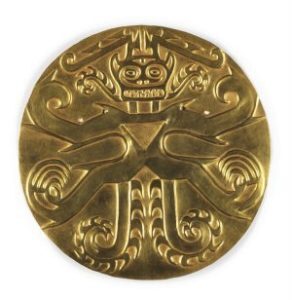
PHILADELPHIA, PA—For more than a thousand years, a cemetery on the banks of the Rio Grande Coclé in Panama lay undisturbed, escaping the attention of gold seekers and looters. The river flooded in 1927, scattering beads of gold along its banks. In 1940, a Penn Museum team led by archaeologist J. Alden Mason excavated at the cemetery, unearthing spectacular finds—large golden plaques and pendants with animal-human motifs, precious and semi-precious stone, ivory, and animal bone ornaments, and literally tons of detail-rich painted ceramics. It was extraordinary evidence of a sophisticated Precolumbian people, the Coclé, who lived, died, and painstakingly buried their dead long ago.
Beneath the Surface: Life, Death, and Gold in Ancient Panama, a new exhibition opening February 7, 2015 at the Penn Museum in Philadelphia, invites visitors to dig deeper, exploring the history, archaeological evidence, and new research perspectives, in search of a greater understanding of the Coclé people who lived from about 700 to 900 CE. Video footage from the original Sitio Conte excavation, video kiosks with opportunities to “meet” and hear from a range of experts, a centerpiece “burial” with interactive touchscreens—and more than 200 objects from the famous excavation—provide an immersive experience. The exhibition runs through November 1, 2015.
One massive burial, named “Burial 11” by the excavators, yielded the most extraordinary materials from the excavation. Believed to be that of a Paramount Chief, it contained 23 individuals in three distinct layers, accompanied by a vast array of grave objects. A to-scale installation of the burial serves as the exhibition’s centerpiece, drawing visitors beneath the surface of the site. The re-creation features many artifacts displayed in the actual positions they were found, as well as digital interactive stations for further exploration.
About the Site
The site of Sitio Conte is situated about 100 miles southwest of Panama City. When golden grave goods were exposed on the banks of the Rio Grande de Coclé, the Conte family, owners of the land, invited scientific excavation. The Peabody Museum of Harvard University carried out the first investigations in the 1930s. In the spring of 1940, J. Alden Mason, then curator in Penn Museum’s American Section, led a Penn Museum team to carry out three months of excavations.
Diary entries, drawings, photographs, and color film from the excavations set the story of the research in time and place. New excavations in Panama, most recently at nearby El Caño, conservation work and laboratory analyses, and ongoing research on Coclé and neighboring Precolumbian cultures, adds to a growing body of knowledge, told through short interviews with Penn Museum and outside experts.
Coclé Culture and Society
Long overshadowed by research on other indigenous Central and South American peoples, the Coclé remain mysterious, but archaeologists, physical anthropologists, art historians, and other specialists are drawing on the materials they have excavated to tell more. The rich iconography, sophisticated gold working technologies and craftsmanship, exacting placement of bodies and materials in the burials: all offer clues about the world view, artistic style, and social hierarchy of the Coclé.
The art and artifacts uncovered from Burial 11 and throughout the Sitio Conte cemetery were rich in cultural meaning and utilitarian value, and Beneath the Surface uses them to begin to create a portrait of the Coclé people. Central to Exhibition Curator Clark Erickson’s vision of “peopling the past” is a contemporary rendering of the central burial’s Paramount Chief; he stands replete with some of the golden pendants, arm cuffs, and plaques, exquisitely crafted and worthy of a great warrior, which he wore to his grave.
Though not identified as direct descendants of the Coclé, many indigenous groups continue to live in Panama and in the region of Sitio Conte today. A small section of the exhibition provides visitors with an opportunity to see contemporary Kuna clothing that echoes some of the design forms and styles of ancient Coclé pottery, pendants, and gold.
Throughout, visitors can explore the evidence and encounter new perspectives on who these people were and how they lived.
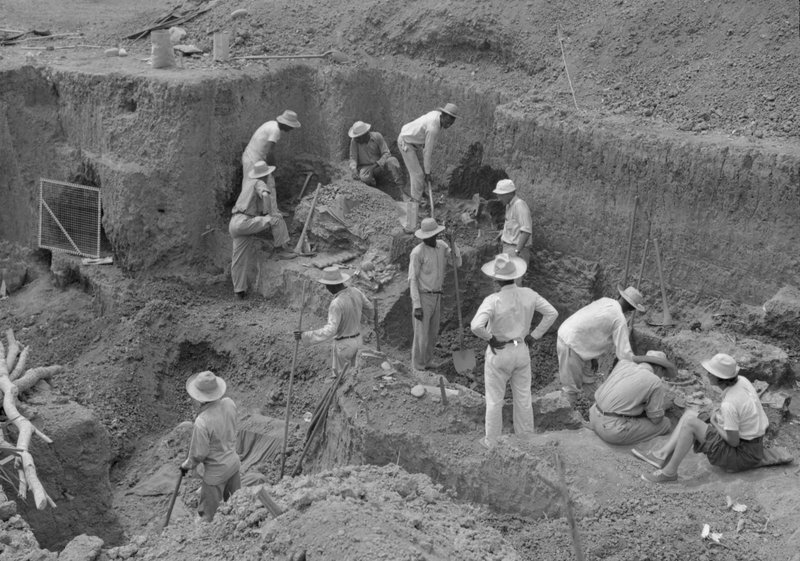 Archival Photograph, Excavations at Sitio Conte, Panama, led by J. Alden Mason of Penn Museum, March 1940. Photograph by R. Merrill.
Archival Photograph, Excavations at Sitio Conte, Panama, led by J. Alden Mason of Penn Museum, March 1940. Photograph by R. Merrill.
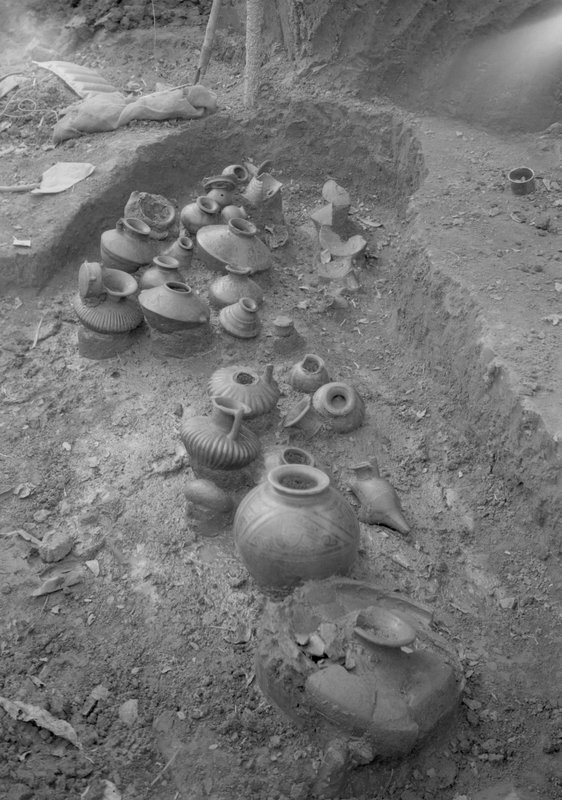 Archival Photograph, Ceramics in Situ, Excavations at Sitio Conte, Panama, led by J. Alden Mason of the Penn Museum, March 1940. Photograph by R. Merrill.
Archival Photograph, Ceramics in Situ, Excavations at Sitio Conte, Panama, led by J. Alden Mason of the Penn Museum, March 1940. Photograph by R. Merrill.
 Ceramic Polychrome Plate (Turtle), Sitio Conte, Panama, ca. 700-900 CE. Photo: Penn Museum.
Ceramic Polychrome Plate (Turtle), Sitio Conte, Panama, ca. 700-900 CE. Photo: Penn Museum.
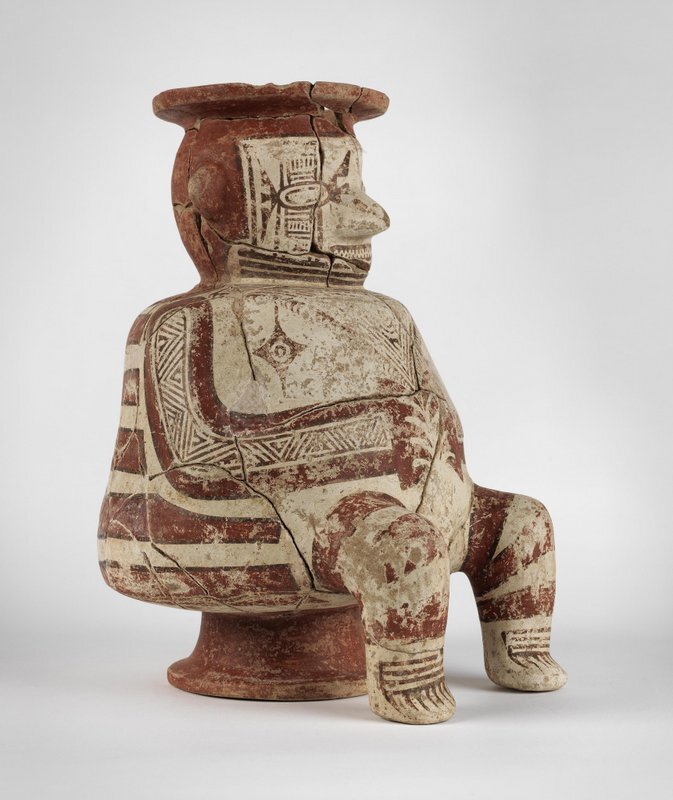 Ceramic Shaman Figure, Sitio Conte, Panama, ca 700-900 CE. Photo: Penn Museum.
Ceramic Shaman Figure, Sitio Conte, Panama, ca 700-900 CE. Photo: Penn Museum.
__________________________________________________________
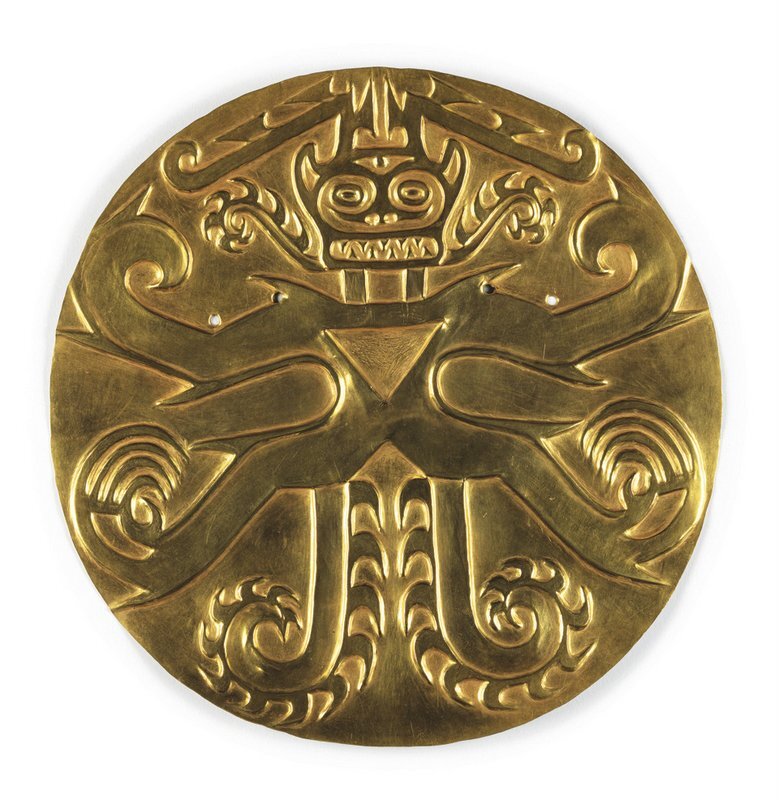 Gold Plaque, Sitio Conte, Panama, ca. 700-900 CE. Photo: Penn Museum
Gold Plaque, Sitio Conte, Panama, ca. 700-900 CE. Photo: Penn Museum
______________________________________________________
Dr. Clark Erickson, Curator-in-Charge, American Section, is the exhibition’s Lead Curator, working with Co-curator Dr. Lucy Fowler Williams, Associate Curator and Sabloff Keeper, American Section; William Wierzbowski, American Section Keeper; and a team of undergraduate Student Assistant Curators, Monica Fenton, Sarah Parkinson, and Ashley Terry of the University of Pennsylvania, and Samantha Seyler of New College, Florida, who provided additional collections and research support. Kate Quinn, Director of Exhibitions and Public Programs, leads the exhibition interpretation and design, working with Christine Locket and Associates (interpretive planning), Alusive Design (exhibition design), and Bludecadet (multimedia design). The exhibition fabrication is provided by Art Guild, Berry and Homer Printing, and the Penn Muiseum Preparation Department, led by Ben Neiditz, Chief Preparator.
Beneath the Surface: Life, Death, and Gold in Ancient Panama is made possible with generous support from the Selz Foundation, Lead Underwriter, the Manning Family Exhibitions Fund, the Susan Drossman Sokoloff and Adam D. Sokoloff Exhibitions Fund, and A. Bruce and Margaret Mainwaring. Global Arena is Language Services Partner.
_____________________________________________
About the Penn Museum
The Penn Museum (the University of Pennsylvania Museum of Archaeology and Anthropology) is dedicated to the study and understanding of human history and diversity. Founded in 1887, the Museum has sent more than 300 archaeological and anthropological expeditions to all the inhabited continents of the world. With an active exhibition schedule and educational programming for children and adults, the Museum offers the public an opportunity to share in the ongoing discovery of humankind’s collective heritage.
The Penn Museum is located at 3260 South Street, Philadelphia, PA 19104 (on Penn’s campus, across from Franklin Field). Public transportation to the Museum is available via SEPTA’s Regional Rail Line at University City Station; the Market-Frankford Subway Line at 34th Street Station; trolley routes 11, 13, 34, and 36; and bus routes 21, 30, 40, and 42. Museum hours are Tuesday through Sunday, 10:00 am to 5:00 pm, and first Wednesdays of each month until 8:00 pm. Open select holiday Mondays. Museum admission donation is $15 for adults; $13 for senior citizens (65 and above); free for U.S. Military; $10 for children and full-time students with ID; free to Penn Museum Members, PennCard holders, and children 5 and younger.
______________________________________________
Source: News Release of the Penn Museum
______________________________________________
Just released!
The special new premium quality print edition of Popular Archaeology Magazine. A beautiful volume for the coffee table.
Travel and learn with Far Horizons.
Read about the most fascinating discoveries with a premium subscription to Popular Archaeology Magazine. Find out what Popular Archaeology Magazine is all about. AND MORE:
On the go? Get the smartphone version of Popular Archaeology as an app or as an ebook.
Popular Archaeology’s annual Discovery Edition eBook is a selection of the best stories published in Popular Archaeology Magazine in past issues, with an emphasis on some of the most significant, groundbreaking, or fascinating discoveries in the fields of archaeology and paleoanthropology and related fields. At least some of the articles have been updated or revised specifically for the Discovery edition. We can confidently say that there is no other single issue of an archaeology-related magazine, paper print or online, that contains as much major feature article content as this one. The latest issue, volume 2, has just been released. Go to the Discovery edition page for more information.







